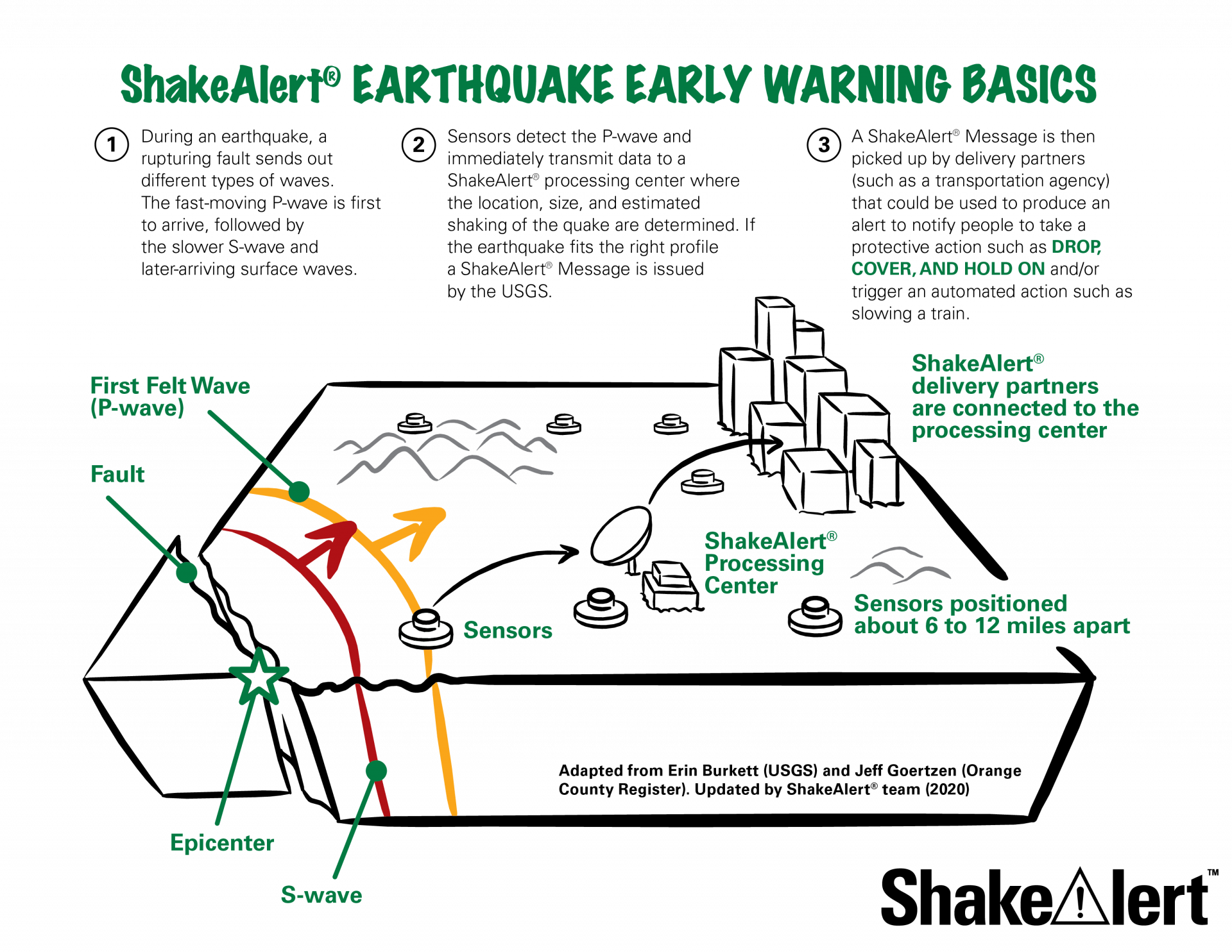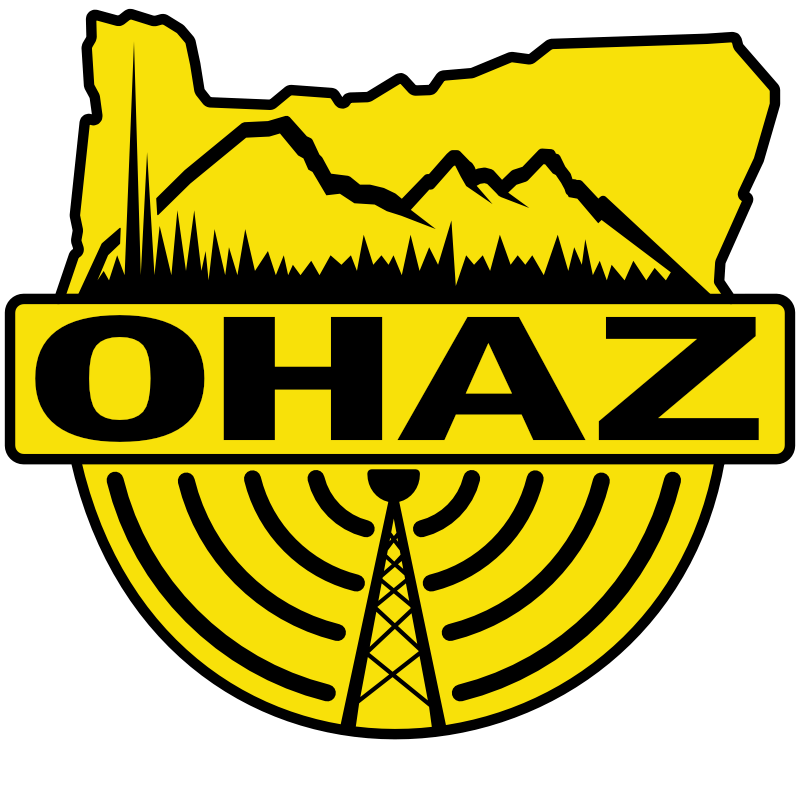ShakeAlert®
An Earthquake Early Warning System for the West CoastThe ShakeAlert Earthquake Early Warning System detects significant earthquakes quickly so alerts can reach people and critical infrastructure before strong shaking arrives. By giving people precious seconds to protect themselves, ShakeAlert can save lives. The ShakeAlert EEW System is managed by the U.S. Geological Survey, but the Oregon Hazards Lab has been a partner in building the ShakeAlert sensor and stakeholder network since 2014:

We install and maintain Pacific Northwest Seismic Network stations in Oregon that contribute data to the ShakeAlert EEW System.

We help schools, hospitals, utilities, and public transit agencies use ShakeAlert-powered technology to protect people and infrastructure.

We collaborate with public agencies, emergency managers, and other stakeholders to ensure their communities have access to EEW.
Oregonians live in earthquake country. In the next 50 years, there is a 37% chance that a powerful earthquake on the Cascadia Subduction Zone and the resulting tsunami could impact the entire Pacific Northwest. There is also a risk that a more moderate but still impactful earthquake could occur on a shallow crustal fault like the Portland Hills Fault. ShakeAlert is an important tool to ensure everyone can live safely and thrive in earthquake country.
Earthquake Early Warning Basics
The ShakeAlert System does not predict earthquakes in advance. Rather, it relies on a dense network of seismic and geodetic stations to detect earthquakes moments after they begin so alerts can reach people before they feel shaking. A network of hundreds of sensors installed across Oregon, Washington, and California continuously record ground motion. In the Pacific Northwest, these sensors are part of the Pacific Northwest Seismic Network. During an earthquake, a rupturing fault sends out different types of waves. The fast-moving P-wave is the first to arrive, followed by the slower S-wave and later-arriving surface wave. Sensors detect the P-wave and immediately transmit data to ShakeAlert processing centers, which use earthquake detection algorithms to estimate the earthquake’s location, magnitude, and shaking distribution. If the earthquake is large enough, a ShakeAlert Message is issued. Licensed alert delivery partners use this data to deliver targeted alerts to people in affected areas. All ShakeAlert Messages are generated automatically by earthquake detection algorithms. However, 24/7 on-call scientists review all alerts for accuracy and will send follow-up Messages if necessary.

The ShakeAlert Earthquake Early Warning System is currently available in Orgon, Washington, and California. ShakeAlert may expand in the future to other high-risk regions, such as Anchorage, Reno, and Las Vegas if seismic networks in those regions are expanded to enable rapid, accurate, and reliable earthquake early warning. Canada and Mexico also operate earthquake early warning systems, although they are distinct from ShakeAlert. The U.S. Geological Survey collaborates closely with its counterparts in Canada and Mexico to share processing software, algorithms, real-time data, and public safety information.
ShakeAlert Alerting Thresholds
ShakeAlert does not deliver alerts for every earthquake. Alerts are only delivered for significant earthquakes that are likely to be felt or cause damage. There are minimum magnitude and intensity thresholds that earthquakes must meet before a ShakeAlert Message is issued.

Additionally, there will always be a region close to the epicenter where people will begin to feel shaking before they receive an alert, as warning time increases with distance from the earthquake’s epicenter. As a result, people may receive an alert before, during, or after shaking arrives at their location. However, most most people in Oregon can expect seconds to tens of seconds of early warning.
Get Earthquake Early Warning Alerts
ShakeAlert earthquake early warning became publicly available in Oregon on March 11, 2021. Oregonians now have several ways to receive earthquake early warning alerts on their phones.
- Wireless Emergency Alert (WEA) System. Like AMBER alerts, these texts are sent automatically to all cell phones. Everyone should check their smart phone’s settings to ensure that emergency alerts are turned on. iPhone users should also turn on “Local Awareness” to ensure they get the fastest alerts.
- Operating System Alerts. Android and Apple have integrated earthquake early warning into their phones’ operating systems, so those users may receive a push notification in addition to a text from the Wireless Emergency Alert System. This notification may include additional information about the earthquake, including its magnitude and distance from the user.
- Downloadable Apps. MyShake (free download from Apple and Google Play stores) delivers push notifications to end-users when an earthquake is detected nearby. Other apps may become available over time. Search for apps that indicate “Powered by ShakeAlert,” as there is no “ShakeAlert” app.

Schools, hospitals, and businesses can also install ShakeAlert technology directly into their facilities. ShakeAlert can also be integrated directly into communication and control systems to trigger a variety of alerts and other actions that protect people and critical infrastructure. This includes delivering pre-programmed alerts in schools and hospitals via paging systems, slowing trains to prevent derailments, shutting down industrial processes to preserve delicate equipment, and throttling water and gas valves to mitigate the fires and floods that often occur after earthquakes due to broken pipelines. Taking such actions before shaking starts can save lives, prevent injuries, mitigate property damage, and reduce recovery costs.
Even though an alert may be received only seconds before shaking arrives, those seconds matter. When you get an alert, immediately Drop, Cover, and Hold On. Do not wait to feel shaking! You can find other recommended protective actions for people with access and functional needs at www.earthquakecountry.org/step5.
Still Have Questions?
Community lifelines, critical infrastructure operators, and businesses that are interested in using earthquake early warning in their facilities should contact our ShakeAlert Coordinator, Kelly Missett, at kmissett@uoregon.edu to learn more.
